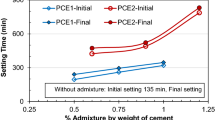Abstract
Effects of admixture type and dosage have been investigated in the scope of this study. The influence of incorporation of chemical admixtures at different dosages on the development of pore structure of cement mortars has also been investigated. A delay on the development rate of strength by incorporation of chemical admixtures at early ages has been determined. The highest strength values were obtained for the cement mortars prepared by naphthalene sulphonate based chemical admixture. The strength values of specimens prepared with overdosage were lower than those of control specimens. Therefore, setting time and flow values were investigated related to admixture dosage and type. Increase in dosage of admixtures results in an increase of setting time and flow values. The pore structure development was given by time and dosage. Maximum pore area ratio values are determined for cement mortars prepared with overdosage. Pore area ratio values decrease by time, as compressive strength values increase.
Similar content being viewed by others
References
ACI 116.R (2005). Cement and concrete terminology (SP-19), American Conrete Institute, ACI.
ACI 212.R-04 (2004). Chemical admixtures for concrete, American Conrete Institute, ACI.
ASTM C 125 (2007). Standart terminology relating to concrete and concrete aggregates, Annual Book of ASTM Standarts.
Crumbie, A. K. (2001). “SEM microstructural studies of cementitious materials: Sample preparation of polished sections and microstructural observations with backscattered images-artifacts and practical considerations.” Proceedings of the 23rd International Conference on Cement Microscopy, Albuquerque.
Detwiller, R. J., Powers, L. J., Jakobsen, U. H., Ahmed, W. U., Scrivener, K. L., and Kjellsen, K. O. (2001). “Preparing specimens for microscopy.” Concrete International, Vol. 23, No. 11, pp. 51–58.
Mindess, S., Young, J. F., and ve Darwin, D. (2002). Concrete (second edition), New York, Prentice Hall.
Scrivener, K. L. (2004). “Backscattered electron imaging of cementitious microstructures: Understanding and quantification.” Cem. Con. Comp., Vol. 26,Issue 8, pp. 935–944.
Skalny, J., Gebauer, J., and Odler, I. (2001). “Scanning electron microscopy in concrete petrography.” Materials Science of Concrete Special Volume: Calcium Hydroxide in Concrete, American Ceramic Society, November 1–3, 2000, Anna Maria Island, Florida, pp. 59–72.
Stutzman, P. (2004). “Scanning electron microscopy imaging of hydraulic cement microstructure.” Cem. Con. Comp., Vol. 26,Issue 8, pp. 957–966.
Wong, H. S., Head, M. K., and Buenfeld, N. R. (2006). “Pore segmentation of cement based materials from backscattered electron images.” Cement & Concrete Research, Vol. 6, No. 6, pp. 1083–1090.
Ye, G., Van Breugel, K., and Faraaij, A. L. A. (2003). “Experimental study and numerical simulation on the formation of microstructure in cementitious materials at early age.” Cem. Concr. Res., Vol. 33, No. 2, pp. 233–239.
Author information
Authors and Affiliations
Corresponding author
Rights and permissions
About this article
Cite this article
Ozturk, A.U., Baradan, B. Effects of admixture type and dosage on microstructural and mechanical properties of cement mortars. KSCE J Civ Eng 15, 1237–1243 (2011). https://doi.org/10.1007/s12205-011-0962-x
Received:
Accepted:
Published:
Issue Date:
DOI: https://doi.org/10.1007/s12205-011-0962-x



